WATER SAFETY IS YOUR RESPONSIBILITY!
Water-related accidents are among the most common cause of death in some of our nation’s most visited parks, forests and waterways. Many drowning victims were not trying to swim but were simply engaging in activities as innocent as wading, taking photos or playing along the stream bank. Those victims attempting to swim in swift waters overestimated their swimming ability and underestimated river currents. None of these drowning victims suspected that tragedy was about to overwhelm them.
Spring and summer activities often find visitors and their children near rivers and streams, enjoying nature's serene sounds or cooling sore feet from a long day's hike. It's important to understand water safety in and around these tempting waters. What can seem peaceful, warm and shallow can prove to be deceptively cold and easily overwhelm the strongest individuals. Each year, unexpected victims, whether purposefully in the water (boating, swimming, wading or crossing streams) or accidentally in the water (scrambling on rocks or even falling while hiking), find themselves in a water rescue situation. - National Park Service
Manifests for Forks of the Kern, Upper and Lower Kern, and the lottery application for Forks of the Kern are available here.
ANYTIME YOU ARE RECREATING IN AND AROUND WATER -- ESPECIALLY WITH CHILDREN, BE AWARE OF YOUR SURROUNDINGS.
Slippery rocks, an unstable shoreline or even a distraction that takes your focus away from the water, can cause an accident -- quickly and quietly.
Check river and stream conditions before heading out on your adventure and always let someone know where you are going and when you will return. River and stream condition information may be found at visitor centers, ranger stations and from weather alerts.
Inquire about swimming regulations. At some recreation sites swimming is not recommended or may even be prohibited. Follow "No Swimming" signs.
Where allowed, choose swimming areas carefully. Often hazards are not visible in what may seem like a good place to swim or wade.
Wear a properly fitting personal floatation device (life jacket) for all river activities. Don’t assume you have the swimming skills to keep you afloat, even the strongest swimmers can drown.
When near rapids or other moving water, always stay on the established trails or developed areas.
Keep a close watch on children even if they are far from the water. Water safety for children is especially important as they can quickly enter the water and get in trouble when your attention is diverted for only a moment.
Never walk, play or climb on slippery rocks and logs near rivers and streams.
Never swim or wade upstream from a waterfall, even if the water appears shallow or calm.
Be cautious of sudden drop offs.


